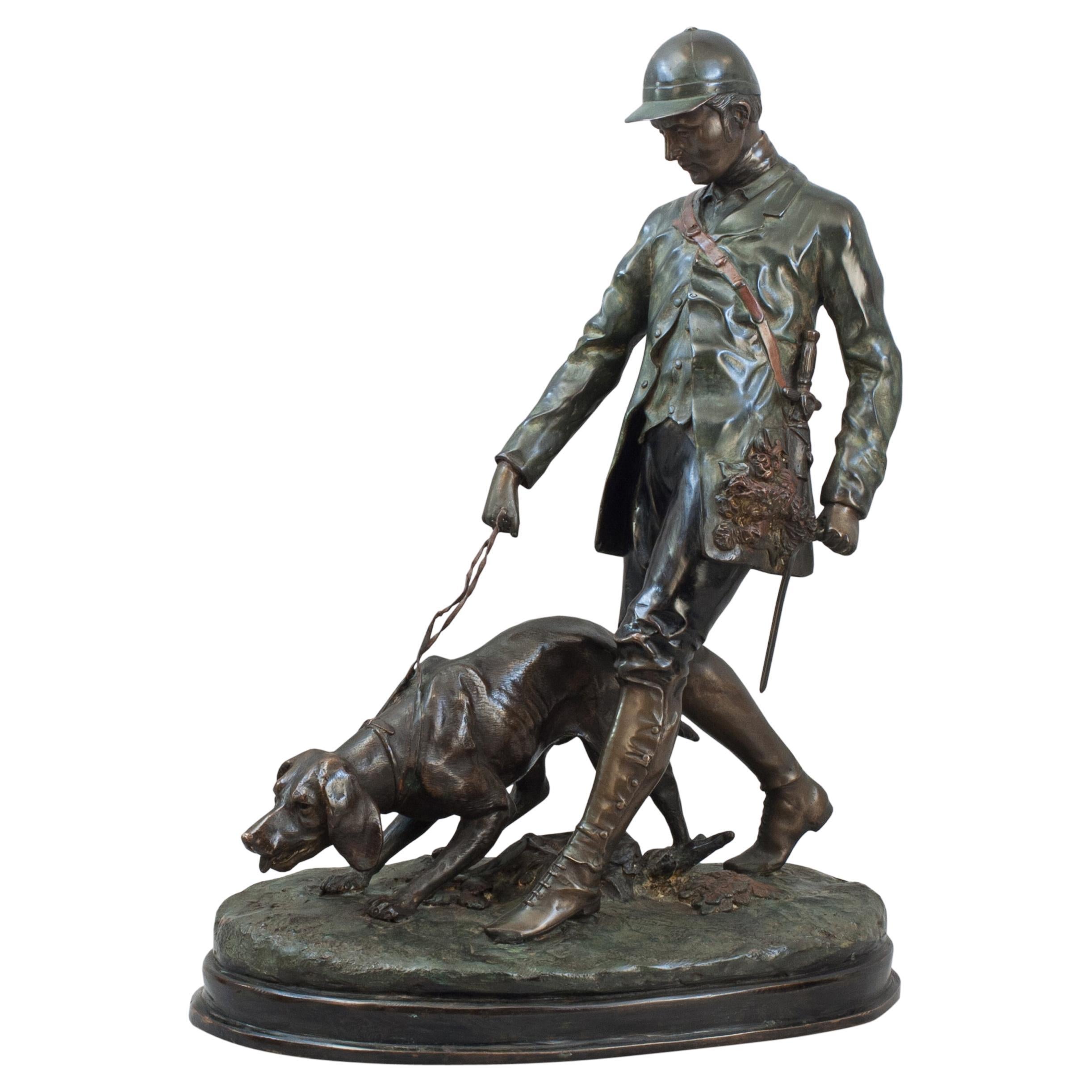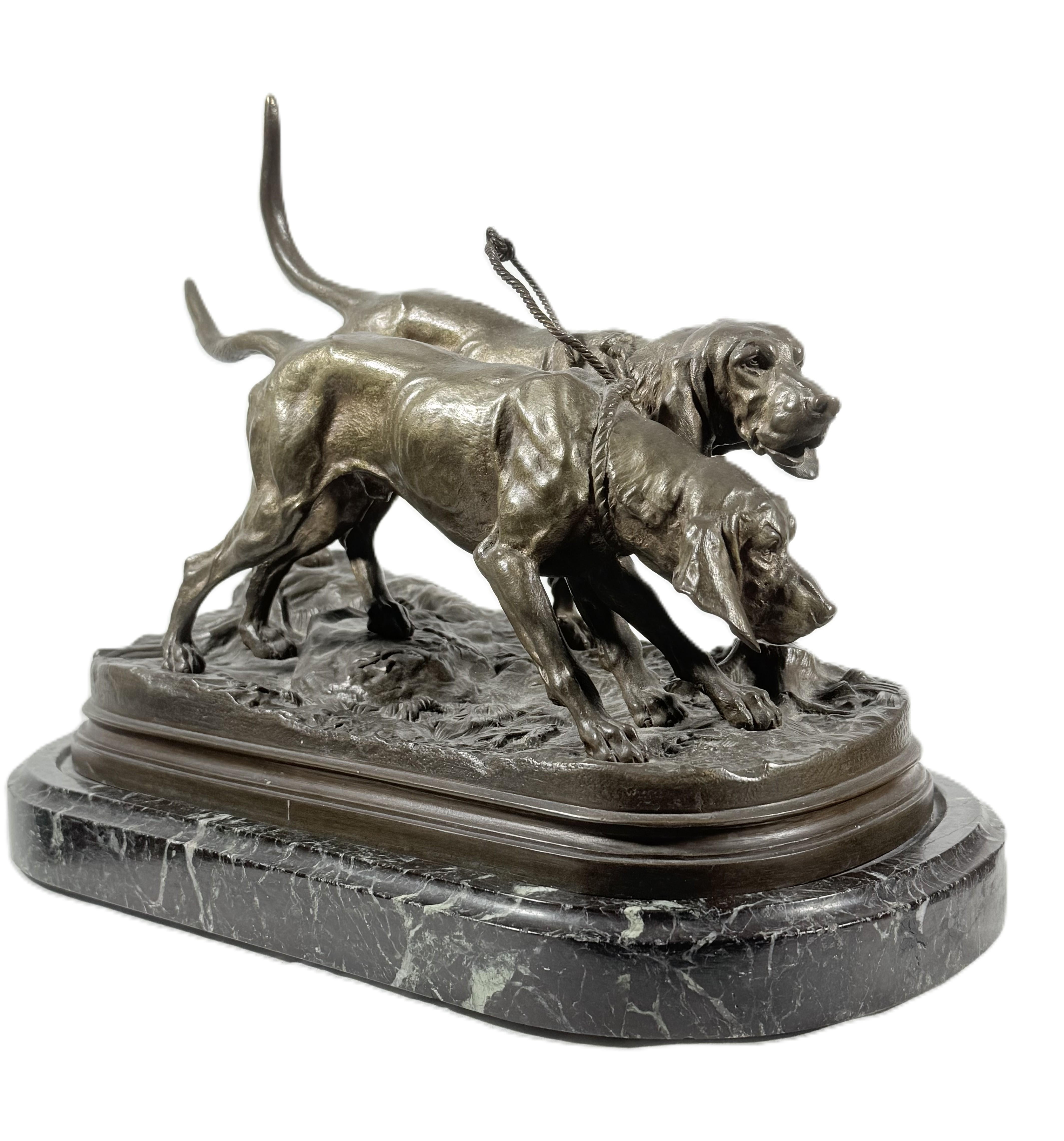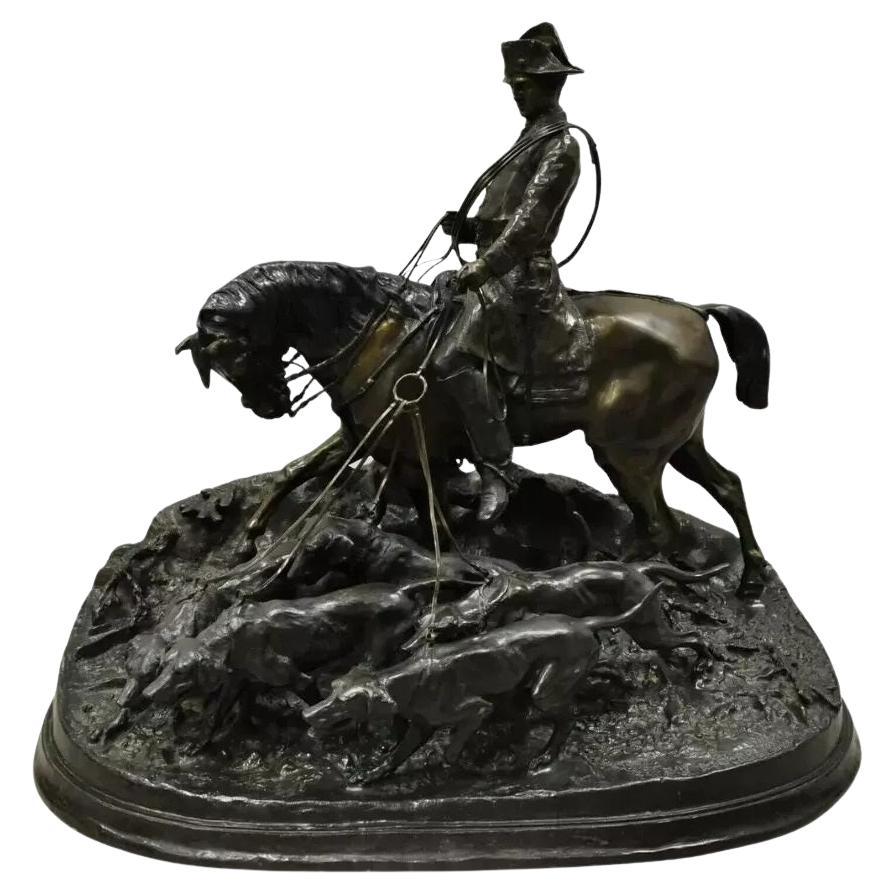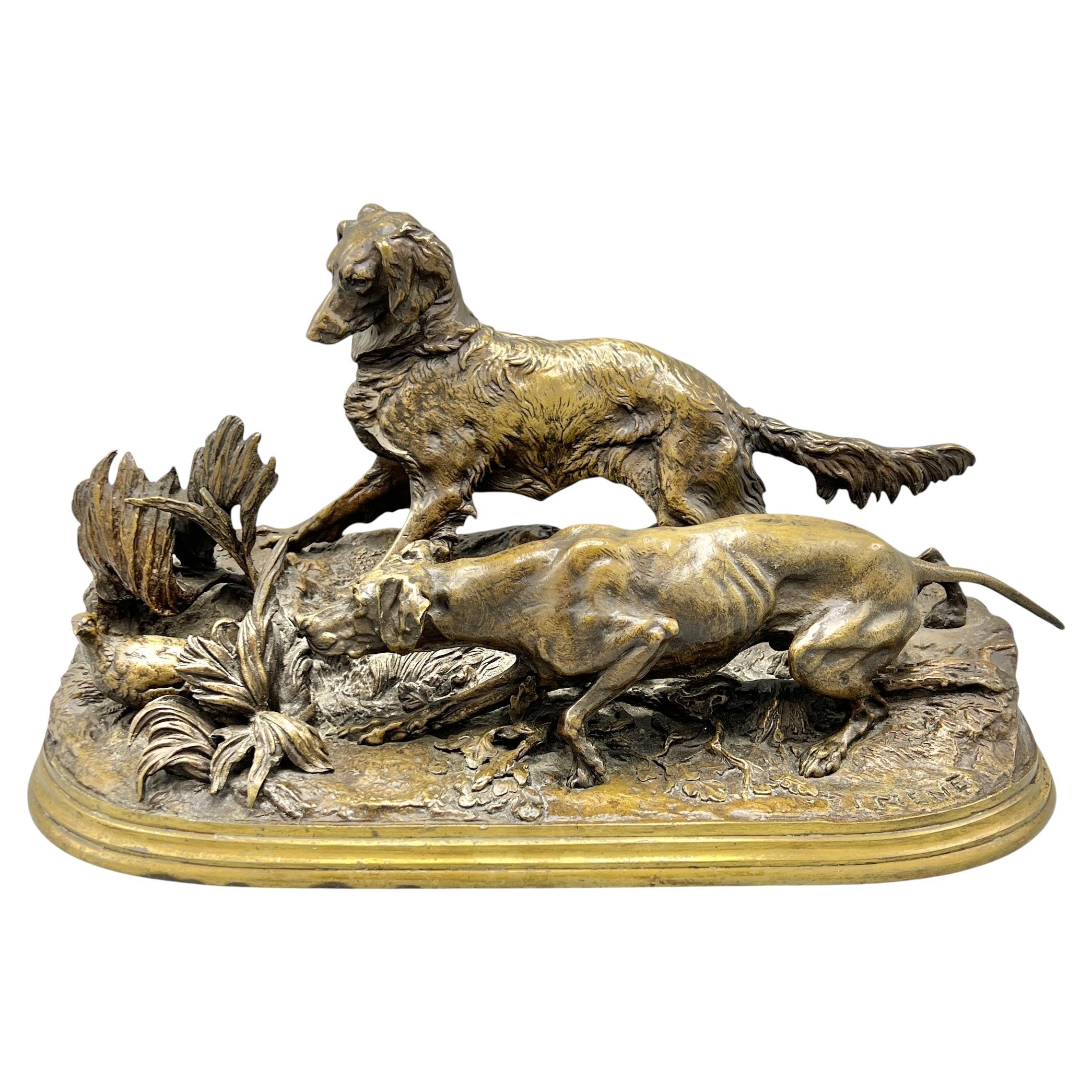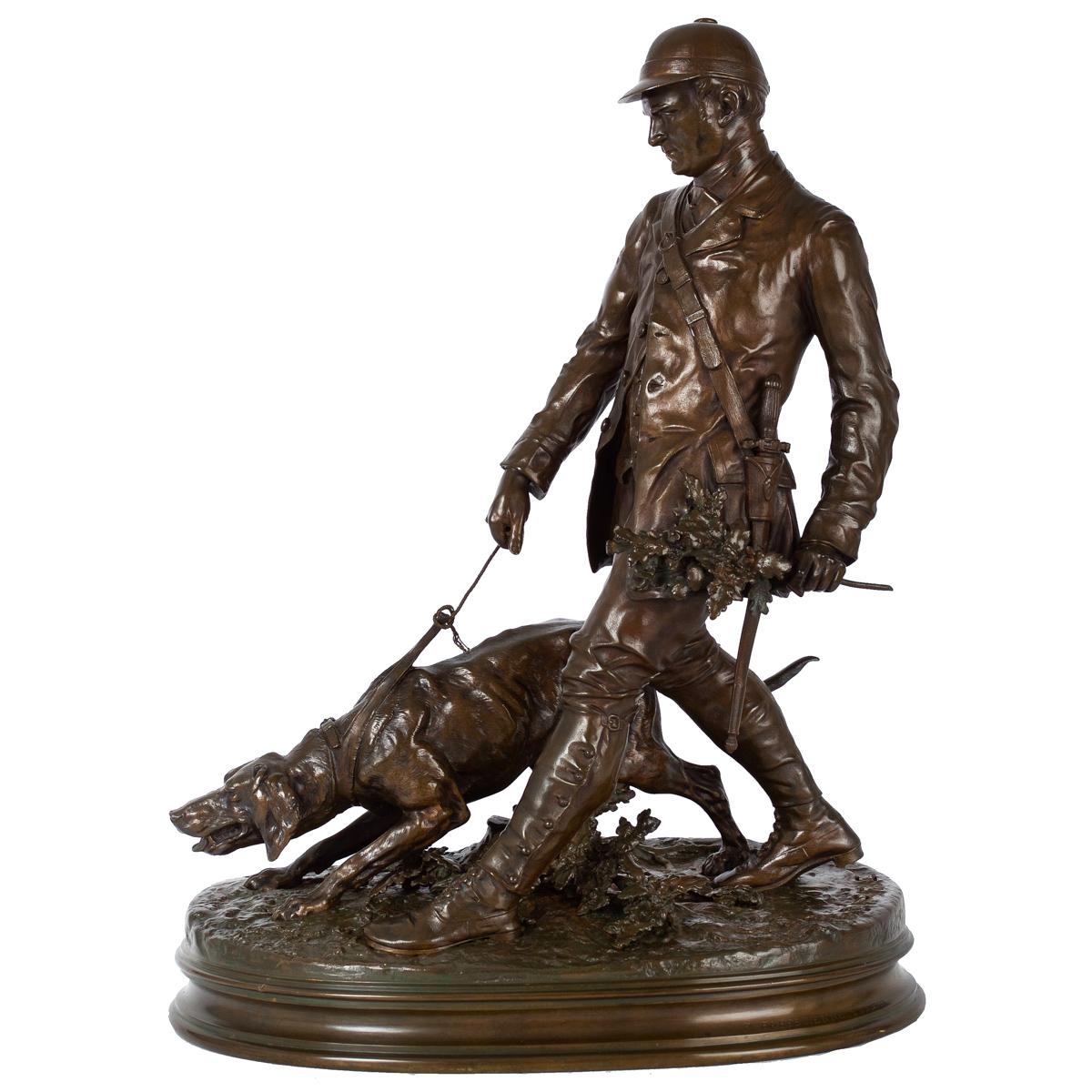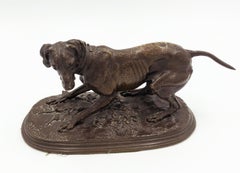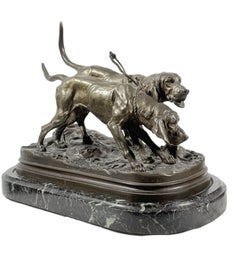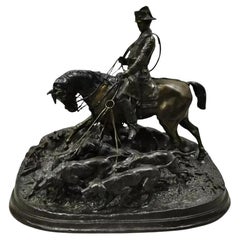Items Similar to The Hunter and Hound
Want more images or videos?
Request additional images or videos from the seller
1 of 5
Pierre Jules MêneThe Hunter and Hound1879
1879
Price Upon Request
Price Upon Request
Price Upon Request
Price Upon Request
Price Upon Request
Price Upon Request
Price Upon Request
Price Upon Request
Price Upon Request
Price Upon Request
Shipping
Retrieving quote...The 1stDibs Promise:
Authenticity Guarantee,
Money-Back Guarantee,
24-Hour Cancellation
About the Item
Pierre-Jules Mene
"The Hunter and Hound" (Le Valet de Limier) 1879
Bronze
approx. 19 x 8 x 14 inches
Signed
PIERRE JULES MENE (1810-1879)
Pierre Jules Mene, (P. J. Mene), was born in Paris in March of 1810 and died in Paris at number 9 Rue de L'Entrepot on May 21, 1879. The son of a metal turner, he received his earliest teaching on sculpture and foundry work from his father, and he opened his own foundry in the 1850s, creating lost-wax castings of his sculptures in bronze. Although mostly self-taught, Mene was encouraged by sculptor Rene Compaire, and was also influenced by two painters: Edwin Landseer of England with his expressive sentimentality, as well as Carle Vernet of France, in capturing spirit, grace and compositional beauty in sculptural form.
Much of Mene's early studies were made at the "Jardin des Plantes" in Paris, where he developed great talent for animal sculpture. He first exhibited the bronze statuette entitled Dog and Fox at the Paris Salon in 1838, and from that time exhibited regularly until his death. He received four awards from the Paris Salon: Second Class in 1848, First Class in 1852 and 1861, and a Third Class award in 1855. Mene did not sculpt statues, but rather bronze statuettes generally of domestic and farm animals at rest, (horses, dogs, cows, bulls, sheep and goats). He modeled over 150 subjects, and received the "Cross of the Legion of Honor" in 1861. He exhibited in England at the Great Expositions of 1855, 1867 and 1878, where he was praised as the "Landseer" of sculpture.
P. J. Mene was one of the most prolific and popular sculptors of the Animalier School, as well as one of it's earliest pioneers. His sculptures were widely collected by the public. His only sculpture acquired by the State of France during his lifetime was the bronze Mounted Huntsman and His Hounds. Charming and charismatic, Mene was accepted socially within the various French artistic communities.
Mene's earliest works, (such as Tiger and Alligator), reflected Antoine-Louis Barye's influence, but in contrast with the romantic style of Barye, Mene's style evolved in a contrasting way. He excelled in realistic portrayals of animals, sculpting each in their natural habitat, capturing fleeting movements and delicate details. Generally, his sculptures were portraits with a hint of human personality. Mene was praised for his "perfection in modeling the figures of animals, and for the truth and beauty of his representations." He worked in the Juste Milieu, blending romantic and naturalist elements while retaining a degree of traditionalism.
Mene's casts were of the highest quality and patinas. The last cast of an addition was edited as sharply as the first, and he was meticulous in the after work of his bronze casts, chiseling extremely fine details. His bronzes were signed in block letters "P. J. Mene" with no foundry marks. He taught his son-in-law, Auguste Cain, who continued Mene's foundries from 1879 to 1892. Subsequently, Mene's models were sold to the Susse Freres Foundry which cast well into the 20th century. Many recasts have been produced.
- Creator:Pierre Jules Mêne (1810 - 1879, French)
- Creation Year:1879
- Dimensions:Height: 19 in (48.26 cm)Width: 8 in (20.32 cm)Depth: 14 in (35.56 cm)
- Medium:
- Movement & Style:
- Period:
- Condition:
- Gallery Location:Missouri, MO
- Reference Number:1stDibs: LU74733396371
About the Seller
5.0
Vetted Professional Seller
Every seller passes strict standards for authenticity and reliability
Established in 1970
1stDibs seller since 2017
155 sales on 1stDibs
Typical response time: 23 hours
- ShippingRetrieving quote...Shipping from: Missouri, MO
- Return Policy
Authenticity Guarantee
In the unlikely event there’s an issue with an item’s authenticity, contact us within 1 year for a full refund. DetailsMoney-Back Guarantee
If your item is not as described, is damaged in transit, or does not arrive, contact us within 7 days for a full refund. Details24-Hour Cancellation
You have a 24-hour grace period in which to reconsider your purchase, with no questions asked.Vetted Professional Sellers
Our world-class sellers must adhere to strict standards for service and quality, maintaining the integrity of our listings.Price-Match Guarantee
If you find that a seller listed the same item for a lower price elsewhere, we’ll match it.Trusted Global Delivery
Our best-in-class carrier network provides specialized shipping options worldwide, including custom delivery.More From This Seller
View AllChien Braque (Tom)
By Pierre Jules Mêne
Located in Missouri, MO
Pierre Jules Mene
"Chien Braque" (Tom)
Bronze
approx. 5 x 9 x 4.25
Signed
PIERRE JULES MENE (1810-1879)
Pierre Jules Mene, (P. J. Mene), was born in Pa...
Category
1860s Realist Figurative Sculptures
Materials
Bronze
Jockey On Horseback
By Hans Guradze
Located in Missouri, MO
Hans Guradze (German, 1861-1922)
"Jockey On Horseback"
Bronze
Approx. 19.5 x 17 x 6 inches
Signed "H. Guradze Berlin" on Base
Category
1890s Realist Figurative Sculptures
Materials
Bronze
Price Upon Request
Lion and Antelope (No. 23)
Located in Missouri, MO
Alfred Barye (1839-1882)
"Lion and Antelope"
Bronze
Approx. 7.5H x 9W x 4D inches
Signed "BARYE.ALF" and Inscribed under base "NO. 23 LION AND ANTELOPE"
The son of a goldsmith, Parisian born Antoine-Louis Bayre was a sculptor of animal subjects and acclaimed, not only for his apparent skill, but as the founder of what became known as the French Animaliers School. Among his patrons were representatives of the state government and royalty including the Duke of Orleans and the Dukes of Luynes, Montpensier and Nemours.
Well compensated financially, he was able to buy the best of materials and hire the country's most skilled foundry craftsmen. The foundry he hired was owned by Ferdinand Barbedienne, and casts from this period were stamped with the letters, FB. However, he did not make a lot of money from his work because he was such a perfectionist that often he would not sell his work because he thought it was not 'quite right'. In 1848, he declared bankruptcy, and his molds and plaster casts were sold along with the copyrights.
Bayre's specialty was aroused, angry seeming wild game such as lions and tigers and elephants, but he also did equestrian groups and mythology figures. In order to do realistic depictions of animal anatomy, he spent much time at the Jardin de Plantes in Paris.
His early training was as an apprentice to a metal engraver, but being drafted in the army in 1812, ended that education. In 1832, he had established his own studio, and unique at that time was his method of cold stamping his bronze casts, so that each one had a special number. He had his first entry, The Milo of Croton...
Category
19th Century Realist Figurative Sculptures
Materials
Bronze
Price Upon Request
Going into Battle
By Carl Kauba
Located in Missouri, MO
Carl Kauba
"Going into Battle" c. 1920s
Bronze with Brown Patina
Signed
approx 10 x 10 x 4 (including wooden base)
This Austrian sculptor was born in Vienna in 1865. His teachers were Karl Waschmann (1848-1905), known for his ivory sculptures and portrait plaquettes of contemporary celebrities, and Stefan Schwartz (1851-1924), who exhibited in Paris, including the Exposition Universelle of 1900 where he won a gold medal. Kauba's intricate bronzes, imported to the United States between 1895 and 1912, were cast at the Roman Bronze Works. Kauba was part of the nineteenth-century tradition of polychrome bronze sculpture. There were several types of patinas on a single statue: he could render the color of buckskin, variously tinted shirts, blankets, feathers, as well as beaded moccasins. Reportedly, Kauba came to America around 1886. Inspired by the Western tales of German author Karl May, he traveled to the West and made sketches and models. Critics, however, pointed out inaccuracies of costume and other details. For instance, the guns that his "mid-nineteenth-century" figures use are models produced after 1898. Apparently he did all of his works back in Vienna.
Besides the variety of color, Kauba's bronzes show a great range of textures and his style is highly naturalistic. The sculptor loved ornament, some of which he rendered with coiled wire for reins, rope and feathers in headdresses. He successfully rendered figures in motion and often executed compositions with more than one figure. Berman (1974) illustrates non-Western subjects by Kaula, such as the pendants Where? and There (ca. 1910), a seated Scottish couple, impressive in the expressions and the details on patterned fabrics of both sitters. Another genre piece is Buster Brown...
Category
Early 20th Century Realist Figurative Sculptures
Materials
Bronze
Price Upon Request
Preparing to Ride
Located in Missouri, MO
Preparing to Ride
By. George B. Marks (American, 1923-1983)
Signed and Dated
Throughout his artistic career, George Marks’s work was always guided by the...
Category
1970s American Realist Figurative Sculptures
Materials
Bronze
Price Upon Request
Piccolo Guerriero (Little Warrior)
By Luciano Minguzzi
Located in Missouri, MO
Luciano Minguzzi (Italian, 1911-2004)
Piccolo Guerriero (Little Warrior) c. 1950s
Bronze
Monogrammed and Numbered 1/5
Height From Base to Top: approx. 12" High
Bronze: 6 3/4 inches x 4W x 3D
Luciano Minguzzi was born in Bologna in 1911 and died in Milan in 2004. In 1943 he took part in the Fourth Quadrennial of Rome. In 1950 he was awarded the grand prize for sculpture at the XXV Venice Biennale, and attended again in 1952.
His works can be found at Museum of the Fabbrica del Duomo, in the Museum of Modern Art in the Vatican and in the Galleries of Modern Art in Rome, Milan, Bologna, Florence, Trieste, Verona, Carrara, Padova, as well as abroad and overseas.
Additional Biography (translated from Italian):
Luciano Minguzzi ( Bologna , 24 May 1911 - Milan , 30 May 2004 ) was a sculptor and medalist Italian .
Image of the exhibition Luciano Minguzzi: sculptures and gouaches 1950-1970 in the Romanesque cloister of the Cathedral of Prato ( Museo dell'Opera del Duomo ), 24 April - 24 May 1971. Photo by Paolo Monti .
Index:
He made his first experiences under the wise guidance of his father, also a sculptor , continuing his studies at the Academy of Fine Arts in Bologna following the engraving courses held by Giorgio Morandi , those of sculpture under the guidance of Ercole Drei , attending at ' university the lessons Roberto Longhi.
Thanks to a scholarship, he stayed in Paris and London , starting to exhibit in 1933 and already at the Roman Quadrennial of 1943 he obtained his first prize, which was followed by others including the Angelicum of 1946 and the first place ex aequo at the Biennale del 1950.
Immediately after the war he created the monument to the Partisan and the Partisan for his hometown , located near Porta Lame , in the area where an epic battle between Nazi-Fascists and partisans took place in 1944 .
The work, composed of two figures of young people - one of which armed - caught in a moment of great naturalness, was forged with cast bronze from the equestrian statue of Benito Mussolini (by Giuseppe Graziosi ) which was located inside the current "Renato Dall'Ara" Stadium, in turn made with some cannons stolen from the Austrians during the Bolognese Risorgimento uprisings of 1848.
Still on the theme linked to war , but with a changed style with more dramatic and expressionist tones , in the fifties he created a series of sculptures inspired by the theme of the men of the Lager and the unknown and anonymous victims, obtaining in 1953 the third prize in the competition for the "Monument to the Unknown Political Prisoner " announced by the Tate Gallery ( London ).
In 1950 he won the competition for the "Quinta Porta" of the Milan Cathedral , completed in 1965 .
In 1962 he participated, together with the most important international sculptors of the time, in the exhibition Sculptures in the city organized by Giovanni Carandente as part of the V Festival dei Due Mondi in Spoleto . He presented a 1958 iron and bronze sculpture entitled Pas-de-quatre.
In 1970 he was given the task of building the "Door of good and evil" of the basilica of St. Peter in the Vatican , on which he worked with vigor and passion for seven years.
In 2012, on the occasion of the centenary of the artist's birth, a posthumous anthological exhibition was set up in Bologna at the Fondazione del Monte [1] .
He also worked as a medalist: his example is the silver 500 lire coin...
Category
Mid-20th Century Modern Abstract Sculptures
Materials
Bronze
Price Upon Request
You May Also Like
Hunting dog on the prowl / - Following the scent -
By Jules Moigniez
Located in Berlin, DE
Jules Moigniez (1835 Senlis - 1894 St-Martin-du-Tertre), Hunting dog on the prowl, around 1880. Dark patinated bronze with naturalistic terrain plinth, 16 cm (height) x 30 cm (length...
Category
1890s Naturalistic Figurative Sculptures
Materials
Bronze
Bronze Sculpture of a Huntsman With Hound
Located in Oxfordshire, GB
Large Hunting Bronze Statue, The Huntsman.
An impressive large vintage bronze sculpture of a huntsman and hound. The hunting hound has caught the...
Category
20th Century Unknown Figurative Sculptures
Materials
Bronze
Alfred Dubucand (1828-1894): Two hunting dogs
Located in Berlin, DE
Dubucand Alfred 1828-1894
Two Hunting Dogs, Bronze on a Marble Base
The bronze with the monogram 'E.V.' and the number '2958'
Two Hunting Dogs, Group Signed Alfred Dubucand, Fren...
Category
Late 19th Century Realist Figurative Sculptures
Materials
Bronze
P.J. Mene The Hunt Scene Large Bronze Sculpture Pierre Jules Statue Horse Dogs
By Pierre Jules Mêne
Located in Philadelphia, PA
P.J. Mene The Hunt Scene Large Bronze Sculpture Pierre Jules Statue Horse Dogs. Item featured is signed to base, "P.J. Mene 1869", artist Pierre Jules Mene, large impressive size, re...
Category
Antique Late 19th Century Unknown Other Figurative Sculptures
Materials
Bronze
French Bronze Sculpture of Hounds Hunting Pheasants After PIerre Jules Mene
By Pierre Jules Mêne
Located in New York, NY
Finely sculpted and cast bronze sculpture of two hounds hunting pheasants after the original model by the French animalier sculptor, Pierre Jules Mene (1810-1879).
Category
Antique Late 19th Century French Animal Sculptures
Materials
Bronze
French Bronze Sculpture "Valet de Limier" by Pierre Jules Mene & Barbedienne
By F. Barbedienne Foundry
Located in Shippensburg, PA
PIERRE JULES MENE
French, 1810-1879
"Valet de Limier" (1879)
Patinated bronze Signed in cast "P.J. MÊNE", incised "F. BARBEDIENNE FONDEUR" to base ...
Category
Antique 19th Century French Romantic Animal Sculptures
Materials
Bronze

